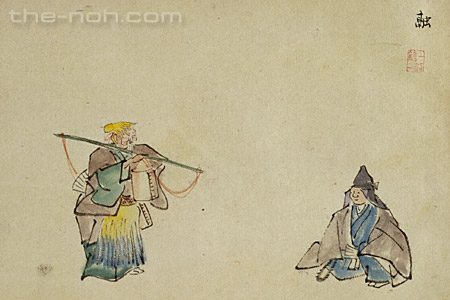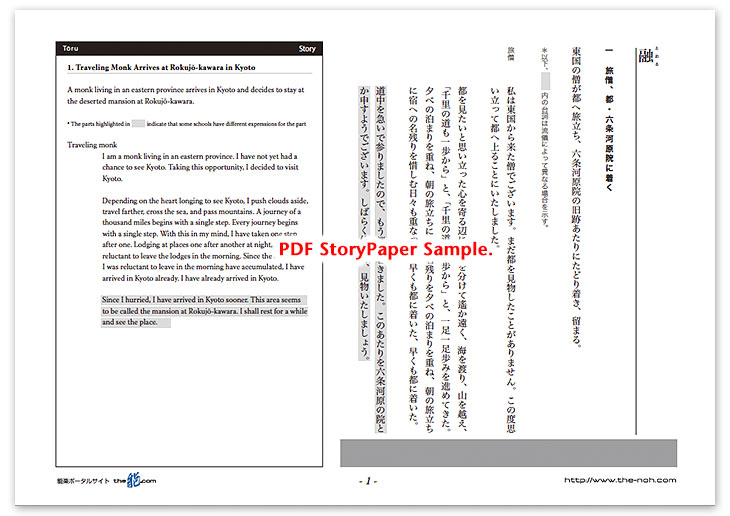
 Tōru
Tōru

![]()
An evening when the exquisite autumn moon shines. When a monk visiting Kyoto from an eastern province comes to the mansion at Rokujō-kawara, he meets an old man carrying buckets to lave brine on a pole. Why does this old man carry buckets for brine at Rokujō-kawara where there is no sea? To the curious monk the old man tells the story that this mansion used to belong to Minamoto no Tōru, who was once called Kawara no Sadaijin (Sadaijin: the Senior Minister of the State) and he lived and re-created here the scenery of Shiogama in Chika in Mutsu Province, a place renowned for laving brine and baking salt. While the old man is telling the story, the rising moon starts to illuminate Rokujō-kawara. A touching autumn evening view spreads in front of their eyes in the moonlight.
Enjoying the scenery of the garden, the monk and old man exchange further words. Tōru requested people to carry brine every day from Naniwa and enjoyed letting people bake sea salt in his garden until his death. However, no one succeeded to his lifelong hobby; and now this mansion is deserted. The monk who seemingly tries to comfort the saddened old man asks him to describe the scenic mountains of Kyoto. Listing the names of the mountains, the old man appreciates the exquisite harvest moon with the monk and comments that he has talked too much. After pretending to lave water, the old man disappears.
The monk who hears the story of the mansion at Rokujō-kawara and the Minister Tōru from a local man notices that the old man was the ghost of the Minister. He goes to sleep. Then, the ghost of Minister Tōru appears in the way he used to be and, illuminated in the moonlight, dances to elegant music. He entertains on a moonlight night as if he has forgotten that time exists. However, at dawn, with his lingering elegant atmosphere, Tōru returns to the capital of the moon.
![]()
Minamoto no Tōru, who was said to be the model of Hikaru Genji in the Tale of Genji, is the twelfth prince of Emperor Saga. He withdrew from the royal family and became an aristocrat. Later although he was promoted to Senior Minister of the State, he lost a power struggle against the Fujiwara clan, which had been gaining power at that time. Minister Tōru therefore built a mansion in Rokujō-kawara and spent the rest of his life elegantly in the mansion. As described in this piece, he loved the scenery of Shiogama in Mutsu Province; it is said that he re-created the scenery within his garden, had people carry seawater from Naniwa every day, and baked salt. Uji-shūi Monogatari (Tale of Uji-shūi) introduces a story that his unbreakable attachment to his mansion makes him appear as a ghost after the death and bothered the subsequent owner of the mansion, a wife of ex-Emperor Uda.
Although in the age of Kannami and Zeami, Minister Tōru was likely to be considered as a vengeful spirit or demon haunting the Rokujō-kawara mansion, this Noh drama focuses on his elegance-loving character and creates the image of Tōru as a fantastical noble figure who lives in the capital of the moon.
This is not a story with dramatic ups and downs; shite or protagonist changes his character from an old man to a noble man and single-mindedly focuses on generating the artistic beauty in the mood for nostalgia in the autumn scenery illuminated by the harvest moon. When you enjoy this drama in which the music and vocals support and enliven the performance of shite and dance and music together express the tender elegance, you will understand that Noh is music, dance, and poetry and is beauty itself which is created by the combination and concert of each separate element.
STORY PAPER : Tōru
Story Paper presents noh chant stories in modern speech, with story outlines, highlights and more using Adobe PDF format, which can print out and zoom in. Print out the pages and take them with you when you see the actual noh performance.

The copyright of Story Paper is held by the Noh.com. Story Paper is for individual use only. It is prohibited by the copyright law to distribute or publish printed-out Story Paper pages without prior consent. For more information, check the credit and disclaimer pages.



 [Tōru : Story Paper PDF : 799KB
[Tōru : Story Paper PDF : 799KB